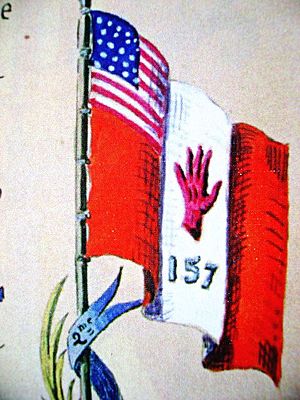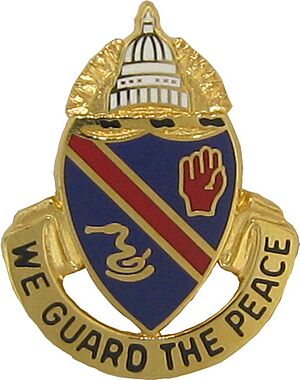372nd Infantry Regiment (United States) facts for kids
Quick facts for kids 372nd Infantry Regiment |
|
|---|---|
| Active |
|
| Country | USA |
| Branch | Army |
| Type | Infantry |
| Motto(s) | Fidelis et Paratus (Faithful and Ready) |
| Engagements | World War I *Champagne–Marne *Meuse–Argonne |
| Decorations | French Croix de Guerre |
| Commanders | |
| Notable commanders |
Col. Herschel Tupes, author 1906 Manual of Bayonet Training |

The 372nd Infantry Regiment was a special regiment in the United States Army. It was made up mostly of African Americans who served as enlisted soldiers. At the time, the army was "segregated," meaning Black and white soldiers were kept in separate units. This regiment also had white officers.
The 372nd Infantry Regiment fought bravely in both World War I and World War II. In World War I, it was part of the 93rd Division. However, it actually fought under the command of the French Army. In World War II, the regiment stayed in the United States and Hawaii, providing important support and training.
Contents
World War I
How the Regiment Was Formed
During World War I, the 372nd Infantry Regiment was created from several different groups. These included:
- National Guard units from places like the District of Columbia, Ohio, Maryland, Tennessee, Massachusetts, and Connecticut.
- About 250 drafted men from Michigan and Wisconsin.
All these units came together to form the 372nd Infantry Regiment.
Fighting in France
The 372nd Infantry Regiment was officially organized in January 1918 in Virginia. Soon after, in March 1918, the regiment moved to France. The 93rd Division, which the 372nd was part of, was never fully put together. So, the 372nd Infantry, along with the 371st Infantry Regiment, joined the 157th Infantry Division of the French Army. This French division was known as the "Red Hand Division."
Under the command of General Mariano Goybet, the American soldiers helped the French fight on the Western Front. They fought in important battles like the Champagne–Marne (from September 28 to October 7, 1918) and the Meuse–Argonne offensive. After these battles, the regiment moved to the Vosges Mountains. The soldiers of the 372nd returned to the United States in February 1919 and were officially released from service.
A monument was built south of Monthois in France to remember the 372nd Infantry Regiment. It honors their brave fighting in the Champagne region, where they faced many challenges.
Brave Actions in Champagne
The 372nd Infantry Regiment showed great courage during their time in the Champagne region of France. Here's a look at some of their key actions:
- September 28, 1918: The 3rd Battalion began its attack, pushing back the enemy. Despite heavy machine gun fire and bombs, they kept moving forward.
- September 29, 1918: The regiment continued to advance quickly, chasing the retreating enemy. Even with rain making conditions tough for the wounded, they pressed on.
- September 30, 1918: The 1st Battalion joined the advance, moving fast through mud and rain. They captured many prisoners, even though enemy machine gun fire was still strong.
- October 1, 1918: The enemy had set up strong defenses on a hill. The regiment faced tough resistance and had little support from French artillery due to the bad ground.
- October 2, 1918: They successfully drove the enemy out of Fontaine-en-Dormois. The enemy was burning supplies as they retreated across the valley.
- October 3, 1918: The regiment captured the village of Ardeuil and a lot of enemy war supplies. They suffered some losses but caused much heavier losses for the enemy.
- October 4, 1918: The 2nd Battalion took over the fighting, while the rest of the regiment rested. They saw enemy trains leaving a nearby town, and their artillery bombed roads and railroads.
- October 5, 1918: German artillery fired heavily, and the enemy launched a counter-attack. The 372nd fought them off in fierce hand-to-hand combat, forcing them back with heavy losses. They took many prisoners and reached the edge of Monthois.
- October 6, 1918: The enemy attacked the French troops on the regiment's left, but they were driven back again. The different parts of the 157th Division worked together very well.
- October 7, 1918: Early in the morning, patrols entered Monthois and captured an enemy machine gun and its crew. The regiment was relieved by a French unit later that night and moved to reorganize.
The regiment then moved to different locations, including Somme-Bionne and Vignemont, before arriving in the Vosges Mountains. Even in November 1918, patrols from the regiment continued to capture enemy soldiers.
Interwar and World War II
After World War I, the 372nd Infantry Regiment was brought back into the National Guard. Its different battalions were based in the District of Columbia, Ohio, and Massachusetts. These units were reorganized and recognized by the government over several years.
On March 10, 1941, the 372nd Infantry was called into active service for World War II. The regiment moved to Fort Dix, New Jersey. After the attack on Pearl Harbor in December 1941, they moved to New York City. They were assigned to the Eastern Defense Command to help with security in the Greater New York area.
Later, in 1944, the regiment moved to Camp Breckinridge, Kentucky. Here, they provided special infantry training to African-American soldiers. These soldiers had previously been in other units or had volunteered to join the infantry.
In 1945, the regiment prepared to go overseas. They traveled to Hawaii, arriving on May 9, 1945. In Hawaii, they took over duties from another division, allowing that division to get ready for a possible invasion of Japan. The 372nd Infantry Regiment was officially closed down in Hawaii on January 31, 1946.
At the end of World War II, the unit was spread out across Hawaii, with different companies stationed at places like Schofield Barracks, Hilo, and Fort Shafter. The history of the regiment is now carried on by other military police and support units.
Campaign streamers
World War II
- Pacific Theater without inscription
Notable members
- Urbane F. Bass: An African American medical officer who was killed in action. He received the Distinguished Service Cross for his bravery.
- Edward Dugger: An African-American lieutenant-colonel.
- Russell Procope: A famous musician.
See also
- 372nd U.S. Infantry regiment on French Wikipedia (in French)


